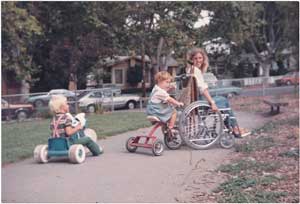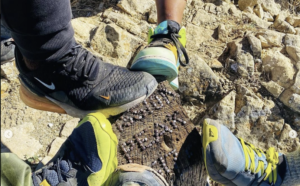I was a backpacker from early childhood, and by my 20s thought myself a rugged adventurer, self-sufficient and in close communion with the natural world of John Muir. Unlike him I always carried a sleeping bag, but I could do without air mattress and (usually) tent, could read a Sierra meadow for the prospect of mosquitoes and the sky for tomorrow’s weather, head out cross-country with compass and topo map, and comfortably share the woods with bears and rattlesnakes.
Then, in 1982, at age 33, I developed progressive multiple sclerosis (MS). Within six months I required crutches to walk and a wheelchair to go more than a few hundred yards.
During those first years, I sometimes felt like a ghost in my own life. The person I had been, my life and dreams, were gone, but I remained, watching the world spin along without me. If I was no longer the outdoorswoman on intimate terms with the backcountry, who thought nothing of shouldering a 30-pound pack and taking off to explore a roadless area on the map . . . if that wasn’t me—and it evidently was not—then who was I?
The very fact of using a wheelchair imposes an identity that is hard to escape. To this day, I can’t feel comfortable while dealing with the intrusive comments of strangers, well-meant or not. The solitude in nature that I had always treasured became more essential yet much harder to find.
On the northernmost shore of Point Pinole, at the end of a little-used level path, there’s a eucalyptus-shaded grassy meadow edging a sandy crescent of beach. It’s a magical place, somehow both cozy and wild. I’d been disabled for three years when I first came here with my husband Dan and the kids. When they wandered off to explore along the shore, I found myself alone with the lapping waves, the peeping of sandpipers, and swallows flashing their reddish breasts in the bright sun.
I can’t say if that moment was sweeter than earlier times engraved in my memory—hunting for frogs along Las Trampas Creek as a 12-year-old, grokking a Point Reyes beach on LSD at 19, crossing a tundra-like Sierra meadow above timberline on a solo trip at 25. But the familiar, long-absent peace that came to me alone on that shore was unexpected and absolute, pushing back the fog of necessities and impossibilities and restoring some missing part of my life. It came to me then that much of what I had lost might be recovered.
- Ann at a Berkeleypark with her children Ben and Foresta in 1983, shortly after the onsetof multiple sclerosis. Photo by Dan Hill.
One thing I had and have is the extraordinary fortune to be married to a man who not only stuck with me when my disability was wrecking his dreams, but shared and made possible the strategies that allowed us to find rewarding alternatives.
When I first developed the symptoms of MS, our children were preschoolers, so for more than a decade we were regulars at Berkeley’s Disability Family Camp, a June weekend at our town’s venerable and rustic Tuolumne campground near Yosemite. Later, Dan and I got in up to our scuppers with BAADS, the Bay Area Association of Disabled Sailors. Over those years we continued to camp by car and hike wherever my chair could be muscled over the terrain. The kids embraced the bargain that had them pushing me up hills and then riding down on my lap (one at a time!).
Until I had to get a power wheelchair in 1995, I had no clue how much it would help with hiking and camping. It made the difference between needing to be pushed over any rough ground and being able to move independently most of the time. Able to visit natural places without getting exhausted, I found myself once again scanning topo maps with excitement.
In spite of increasing disability, I’ve salvaged a version of my identity as an outdoorswoman. I can’t hike alone in remote places, nor am I physically fit by any measure, but I’m once again at home in nature. To the standard-issue woodsy lore of our youth, Dan and I have added—sometimes invented—the skills needed to take a wheelchair out in the tules.
It’s a different kind of adventure. Unused roads are often wheelchair-possible, as are firebreaks. Many stretches of trail are easy, and give us a chance to do what we love most: savor the peace and solitude, keeping alert for birds, bugs, and all kinds of natural features. But around any bend we may encounter tough going. Maybe it’s a steep descent, harder than climbing if my drive wheels lose traction. At times I have to take grades backwards.
At eroded or rocky spots, we’ll stop and plan a route. Dan pushes as we go, wrenching the chair sideways if it skews in the wrong direction. With its low center of balance, my 200-pound chair is very unlikely to tip over, but it gets stuck easily and can be hard to extract.
We often have to turn back; it doesn’t take much in the way of rocks, roots, or ruts to stop any wheelchair. We can’t travel narrow footpaths or soft sand, or ford even a shallow stream. Such natural barriers are inevitable, and for the most part, we’ve come to regard them as different only in degree from the limitations any hiker faces. At 20 I gave myself a memorable scare scrambling up dangerous scree slopes in the Minarets in search of an unnamed, perhaps nonexistent, pass. It didn’t make me want the Army Corps of Engineers to cut me a road, and neither do natural obstacles I meet today.
Man-made barriers are another matter. Ditches and logs laid to control erosion can stop a wheelchair cold, as can a single step at the end of a footbridge. If the bridge itself isn’t wide enough, we’re skunked. Narrow pass-throughs and stiles at trailheads exclude wheelchairs even better than they do motorcycles.

-
Ann maneuvers her power chair over ruts at this trailheadgate in the Marin Headlands (Golden Gate National Recreation Area), afrequent problem at such gates where traffic is concentrated. Photo byDan Hill.
Sometimes these obstructions appear in the same parks that have a fully accessible visitors center and 200-yard nature trail, sending the alienating—if unintended—message that for disabled people the outdoors is available only at “special” facilities. It is hard to describe how painful it is to be excluded through simple indifference, or through the ignorance of planners who see no need to maximize the usability of trails that are not designated “whole access.”
A third kind of obstacle, and the focus of my personal crusade, is the difficulty of finding out about semi-accessible trails, that is, those not formally designated, but still usable by many people with mobility impairments. Trail guides, activity schedules, and park brochures usually contain little or no such access information, making them useless for a wheelchair user. Too often, park rangers are also unable to answer questions about a trail’s usability—it’s either designated as accessible or not, end of discussion.
Since I’m spectacularly unqualified to pick up a hoe and fix trail barriers, I do my part instead by writing reviews of routes I’ve hiked with Dan and others and posting them on my web site, wheelchairtrails.net. The hunt for usable trails has become a rewarding quest, and writing about them is almost like hanging trophies on the wall.
We sometimes take expeditions where nothing we try pans out, and the limitations of the wheelchair seem insurmountable. But usually either we find a marginally navigable route and go boldly where no wheelchair has gone before, or really, ever should go again—or else, we discover a more sensible trail, worthy of a full report. And when we come home with both, an accessible trail strapped on our fender and another story to tell about one that wasn’t accessible but we did it anyway—now that’s a good day!

.jpg)




